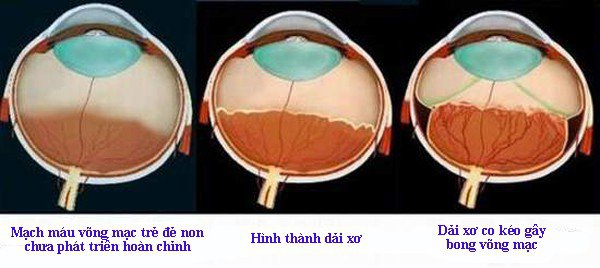Why do premature and low birth weight babies need to be screened for retinopathy of prematurity?
This is an automatically translated article.
The article was consulted with Specialist II Chung Thi Mong Thuy - Pediatrician - Neonatologist - Department of Pediatrics - Neonatal, Vinmec Central Park International General Hospital.
Retinopathy is common in premature, low birth weight infants. The higher the incidence of the disease, the younger the gestational age. About 90% of retinopathy of prematurity is mild, the disease can regress on its own and has no long-term effects. The remaining 10% progressed to severe disease requiring surgical intervention and close follow-up. Therefore, parents need to take their children for regular check-ups and regular monitoring to avoid complications of vision impairment, possibly even blindness later in life.
1. What is retinopathy of prematurity?
Eyes begin to develop around week 16 of pregnancy, when blood vessels of the retina begin to form in the cord along with the optic nerve located behind. Blood vessels grow gradually toward the edge of the retina, supplying oxygen and nutrients.
During the last 12 weeks of pregnancy, eyes develop rapidly. If the baby is born at term, the development of the retinal blood vessels is almost complete (the retina usually ends a few weeks to a month after birth). But if a baby is born early, before these blood vessels grow to the edge of the retina, normal growth can stop. As a result, the periphery may not receive enough oxygen and nutrients. As a result, abnormal circuits begin to develop. These abnormal new blood vessels are fragile and vulnerable to risk factors (such as oxygen poisoning) that cause bleeding and scarring in the retina. As this scar shrinks, they pull on the retina causing it to separate from the bottom of the eye (retinal detachment). Therefore, children need to be screened for retinopathy of prematurity to limit complications.
This disorder usually develops in both eyes and is one of the common causes of vision impairment or permanent blindness.
During the last 12 weeks of pregnancy, eyes develop rapidly. If the baby is born at term, the development of the retinal blood vessels is almost complete (the retina usually ends a few weeks to a month after birth). But if a baby is born early, before these blood vessels grow to the edge of the retina, normal growth can stop. As a result, the periphery may not receive enough oxygen and nutrients. As a result, abnormal circuits begin to develop. These abnormal new blood vessels are fragile and vulnerable to risk factors (such as oxygen poisoning) that cause bleeding and scarring in the retina. As this scar shrinks, they pull on the retina causing it to separate from the bottom of the eye (retinal detachment). Therefore, children need to be screened for retinopathy of prematurity to limit complications.
This disorder usually develops in both eyes and is one of the common causes of vision impairment or permanent blindness.

Bệnh lý võng mạc sinh non
2. Time to check Rop for premature babies
First eye exam: 4 weeks postpartum
Follow up every 1-2 weeks Depending on the progression of the disease, follow up until the retina matures, the disease completely regresses or there is an indication for treatment.
Follow up every 1-2 weeks Depending on the progression of the disease, follow up until the retina matures, the disease completely regresses or there is an indication for treatment.
3. Stages of retinopathy of prematurity
Retinopathy of prematurity is classified according to 5 stages ranging from mild to severe.
Stage 1: mild vascular growth. A thin white line appears, separating the two areas: the vascularized retina and the avascular retina. In stage 1, the blood vessels can continue to develop normally, but the doctor needs to closely monitor the child's condition. Many children with stage 1 disease improve without treatment and eventually develop normal vision. The disease resolves on its own with no further progress Stage 2: Moderately abnormal blood vessel growth. At this time, the boundary line between the vascularized retina and the avascular retinal area became more visible and grew away from the retinal surface, becoming wide and high forming a white ridge ( if few blood vessels) or pink (if many blood vessels). Many children who develop at this stage are also able to improve on their own without treatment.
Stage 3: Severe abnormal blood vessel growth. This is the stage of extraretinal vascular fibrillation. From the surface of the ridge, fibrovascular tissue proliferates and spreads to the posterior surface of the retina; or develop anteriorly, perpendicular to the retinal plane into the vitreous. In stage 3, ROP disease is also divided by mild, moderate and severe; depending on the extent of proliferation of vascular tissue into the vitreous.
Stage 1: mild vascular growth. A thin white line appears, separating the two areas: the vascularized retina and the avascular retina. In stage 1, the blood vessels can continue to develop normally, but the doctor needs to closely monitor the child's condition. Many children with stage 1 disease improve without treatment and eventually develop normal vision. The disease resolves on its own with no further progress Stage 2: Moderately abnormal blood vessel growth. At this time, the boundary line between the vascularized retina and the avascular retinal area became more visible and grew away from the retinal surface, becoming wide and high forming a white ridge ( if few blood vessels) or pink (if many blood vessels). Many children who develop at this stage are also able to improve on their own without treatment.
Stage 3: Severe abnormal blood vessel growth. This is the stage of extraretinal vascular fibrillation. From the surface of the ridge, fibrovascular tissue proliferates and spreads to the posterior surface of the retina; or develop anteriorly, perpendicular to the retinal plane into the vitreous. In stage 3, ROP disease is also divided by mild, moderate and severe; depending on the extent of proliferation of vascular tissue into the vitreous.

Một số giai đoạn của bệnh lý võng mạc sinh non
Stage 4: The fibrous tissue grows strongly into the vitreous cavity, causing a state of contraction and pulling on the retina, causing a part of the retina to detach from the wall of the eyeball. Based on the location of the retinal detachment, this stage is divided into two parts: 4A and 4B. * Stage 4A: the function of the eye at this time has not been damaged much. The retinal detachment has not yet spread to the macula.
* Stage 4B: eye function is markedly reduced. The retinal detachment is more extensive and extends to the retina in the macular region.
Stage 5: Total retinal detachment. The detached retina has a funnel shape. There are three types of hopper: open hopper, closed hopper, front closed, rear open. Possibility of permanent blindness.
* Stage 4B: eye function is markedly reduced. The retinal detachment is more extensive and extends to the retina in the macular region.
Stage 5: Total retinal detachment. The detached retina has a funnel shape. There are three types of hopper: open hopper, closed hopper, front closed, rear open. Possibility of permanent blindness.
4. Treatment of retinopathy of prematurity
Two treatments for retinopathy of prematurity have been shown to be effective: laser photocoagulation therapy or injections of Avastin
* AVATIN is a class of angiogenesis inhibitor monoclonal antibody A (VEGF-A). has been used by many countries in the world such as the US, Canada, Mexico, Chile, Germany, the Netherlands, Turkey, Taiwan, Thailand... and Vietnam in the treatment of retinopathy of prematurity and for very good results. Thanks to this treatment method, thousands of children around the world can avoid blindness due to ROP. Intraocular injection of Avastin. The drug can be used early before laser treatment or used late when laser treatment fails. Usually the best results are at stage 3+
*Laser therapy burns away the peripheral areas of the retina that do not have normal blood vessels. This treatment destroys the peripheral area of the retina, slowing or reversing the abnormal growth of blood vessels.
For children with more severe disease, other treatments are performed but the results are not satisfactory.
Removal of the vitreous in the eye: This involves removing the vitreous or replacing it with saline. After the vitreous is removed, the scar tissue on the retina can be peeled off or cut away, allowing the retina to no longer stretch.
Membrane flexion: This method will use a silicone band around the eye and tighten it will prevent the vitreous gel from pulling on the scar tissue and allow the retina to flatten
Retinopathy of prematurity is treatable and If the disease is treated early, it is highly effective, so premature babies need to be screened for regular eye exams under the guidance of a doctor.
* AVATIN is a class of angiogenesis inhibitor monoclonal antibody A (VEGF-A). has been used by many countries in the world such as the US, Canada, Mexico, Chile, Germany, the Netherlands, Turkey, Taiwan, Thailand... and Vietnam in the treatment of retinopathy of prematurity and for very good results. Thanks to this treatment method, thousands of children around the world can avoid blindness due to ROP. Intraocular injection of Avastin. The drug can be used early before laser treatment or used late when laser treatment fails. Usually the best results are at stage 3+
*Laser therapy burns away the peripheral areas of the retina that do not have normal blood vessels. This treatment destroys the peripheral area of the retina, slowing or reversing the abnormal growth of blood vessels.
For children with more severe disease, other treatments are performed but the results are not satisfactory.
Removal of the vitreous in the eye: This involves removing the vitreous or replacing it with saline. After the vitreous is removed, the scar tissue on the retina can be peeled off or cut away, allowing the retina to no longer stretch.
Membrane flexion: This method will use a silicone band around the eye and tighten it will prevent the vitreous gel from pulling on the scar tissue and allow the retina to flatten
Retinopathy of prematurity is treatable and If the disease is treated early, it is highly effective, so premature babies need to be screened for regular eye exams under the guidance of a doctor.

Phương pháp điều trị bệnh bong võng mạc bằng laser
Some points to note when taking premature babies for ROP examination at the Hospital:
Parents should not breastfeed their babies 1 hour before the eye exam to avoid vomiting and inhaling dangerous foods.
To accurately examine the baby's eyes, the baby needs to drop copper dilating medicine 3-4 times, so it takes 45-60 minutes for the medicine to take effect. Therefore, parents should choose the right time to visit the hospital.
At Vinmec International Hospital, we are applying laser treatment of retinal detachment and Avastin injection with the advantage of improving visual function for children. patient.
Parents should not breastfeed their babies 1 hour before the eye exam to avoid vomiting and inhaling dangerous foods.
To accurately examine the baby's eyes, the baby needs to drop copper dilating medicine 3-4 times, so it takes 45-60 minutes for the medicine to take effect. Therefore, parents should choose the right time to visit the hospital.
At Vinmec International Hospital, we are applying laser treatment of retinal detachment and Avastin injection with the advantage of improving visual function for children. patient.
Please dial HOTLINE for more information or register for an appointment HERE. Download MyVinmec app to make appointments faster and to manage your bookings easily.
This article is written for readers from Sài Gòn, Hà Nội, Hồ Chí Minh, Phú Quốc, Nha Trang, Hạ Long, Hải Phòng, Đà Nẵng.





